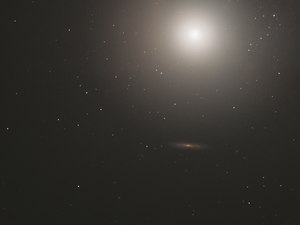Messier 89
| Galaxy Messier 89 |
|
|---|---|

|
|
| Hubble image of the elliptical galaxy Messier 89 | |
| AladinLite | |
| Constellation | Virgin |
|
Position equinox : J2000.0 , epoch : J2000.0 |
|
| Right ascension | 12 h 35 m 39.8 s |
| declination | + 12 ° 33 ′ 23 ″ |
| Appearance | |
| Morphological type | E; LINER; HII Sy2 |
| Brightness (visual) | 9.9 likes |
| Brightness (B-band) | 10.9 likes |
| Angular expansion | 3.5 ′ × 3.5 ′ |
| Surface brightness | 12.7 mag / arcmin² |
| Physical data | |
| Redshift | +0.001134 ± 0.000014 |
| Radial velocity | +340 ± 4 km / s |
|
Stroke distance v rad / H 0 |
(13 ± 1) x 10 6 ly (3.97 ± 0.29) Mpc |
| history | |
| discovery | Charles Messier |
| Discovery date | March 18, 1781 |
| Catalog names | |
| M 89 • NGC 4552 • UGC 7760 • PGC 41968 • CGCG 070-184 • MCG + 02-32-149 • GC 3097 • h 1348 • VCC 1632 | |
Messier 89 (also known as NGC 4552) is a 9.9 mag bright elliptical galaxy with an area of 3.5 '× 3.5' in the constellation Virgo .
M89 appears practically circular and is of type E0 in the Hubble sequence . However, in the 1990s , an extensive shell extending outward for about 150,000 light years was discovered. M89 was the first galaxy to have such a shell discovered. A jet-like structure was also discovered, which indicates that another galaxy is in the process of dissolving in M89.
Unlike the similarly sized galaxy Messier 90 , which is only 0.6 ° north, it moves at a similar rate to us away . This can be explained by the dynamics of the very massive Virgo Cluster.
discovery
Messier 89 was discovered by Charles Messier on March 18, 1781 .


